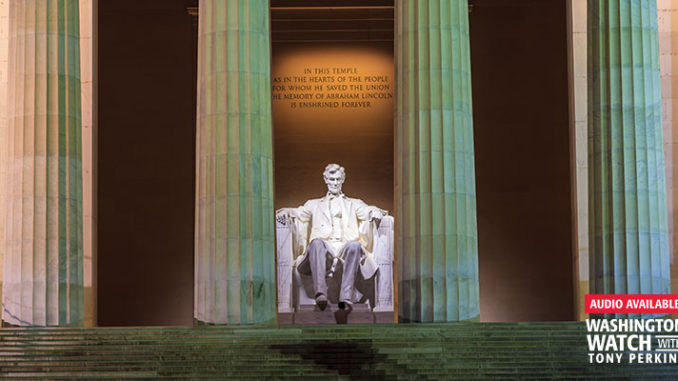

It’s not easy to find a place to stash 1,600-pound statues. In Virginia, local reporters were shocked to find out that their toppled leaders had ended up at a Richmond wastewater treatment plant, covered in bright blue tarps. It was a fast trip for the soldiers, who went from lining Monument Row to sitting in dirt outside the local sewage works. Even now, no one is quite sure what to make of this marble morgue, except to wonder: who else will be next? According to the people around the president’s table — no one, if they can help it.
While Virginia tries to flush its history down the city’s tubes, the administration is coming after anyone who defaces, damages, or tries to remove any monument by force. Using a combined team from his Justice, Interior, and even Homeland Security agencies, President Trump has made it clear: “My administration will not allow violent mobs, incited by a radical fringe, to become the arbiters of the aspects of our history that can be celebrated in public spaces.” If these agitators want to vandalize sacred places, they’ll pay for it, he vowed — with up to 10 years in federal prison.
Micah Avery, the 26-year-old whose handiwork ended up in all of the newspapers after he graffitied the Lincoln Memorial, may be public example number one. U.S. Park Police chased down the man after the first night of looting in D.C., finding a spray paint can in his pocket and a message on his iPhone warning him the officers were coming.
“The president has really taken some bold action,” Interior Secretary David Bernhardt agreed on Tuesday’s “Washington Watch.” “He’s basically issued a direction to us and to the Department of Justice that says investigate these crimes, prosecute these people to the full extent of the law, bring the entire force of the federal government to [bear]. And what people need to know, and the criminals who commit these crimes need to know is that there are very severe penalties — up to 10 years in prison in certain cases and also tremendous financial consequences. And we are rounding up these bad actors.”
So far, they haven’t been too hard to track down. “Many of them love video cameras,” Bernhardt shook his head, “and they’re finding out that those are difficult to deal with in the evidence room…” Turns out, our social media culture has been a huge help to Park Police. Even Bernhardt had to shake his head at some of the posts his team has seen. “I mean, if you take a selfie as you’re committing a crime, that’s an awkward thing. Let’s just be honest.”
And yet, as President Trump pointed out, there isn’t a shortage of ignorance among these rioters — as evidenced by the targets they’ve picked and the people they’ve smeared. That’s one of the reasons the White House wants to move forward with a special park where children and adults alike can learn about our country’s heroes. “These statues of stone are really silent teachers,” Bernhardt insisted, “and we need to do a better job as Americans, making sure that America’s stories told.”
As for the monuments where there’s consensus their time has past, the answer isn’t mob violence. “If someone has a strong view about a memorial or a statue,” Bernhardt pointed out, there’s an avenue for that. You can petition Congress and have them address it. It’s ultimately the people’s property… But if they come and they want to destroy property, they’re going to deal with us — and we’ll deal with them severely.”
The problem is, and NRO’s Conrad Black writes, “We find ourselves in the middle stages of a cultural riot in which everything — and everyone — has become fair game.” Are we a nation of imperfect people? Absolutely. But good luck burning down this country and finding a better one, Henry Olsen warns. “There is no pure past to which one can turn for intellectual sustenance if one desires a political regime dedicated to freedom and equality.”
The extremists like to say that this violence is about justice. That somehow by attacking our past, they’re improving our future. But people have been pulling down statues in this country for two and a half centuries. The difference is, our founders were trying to end tyranny — the mobs only want to create it.
